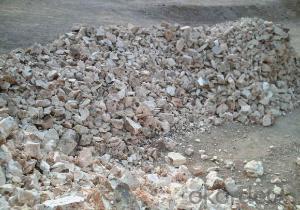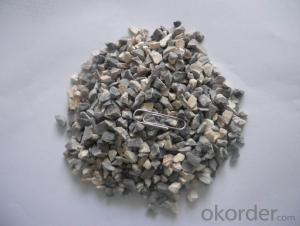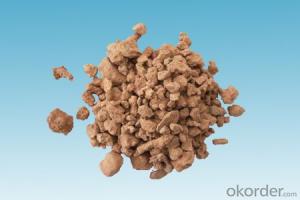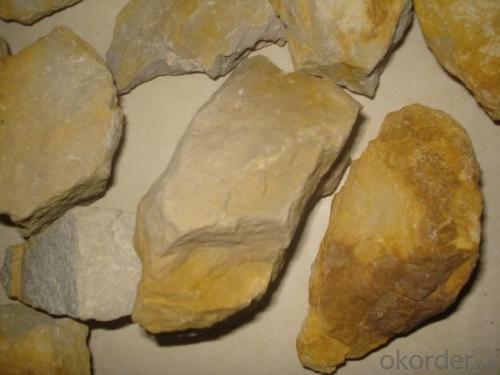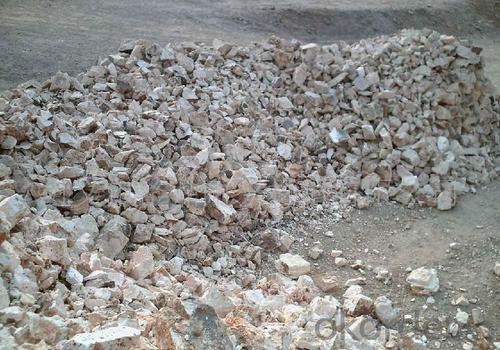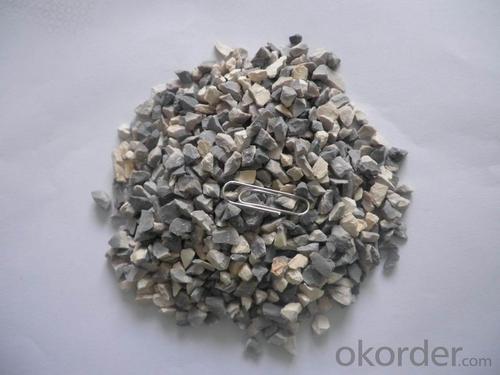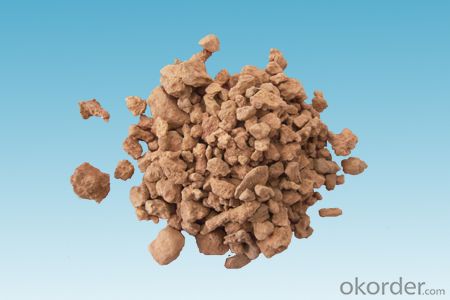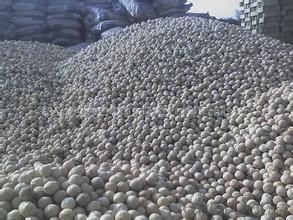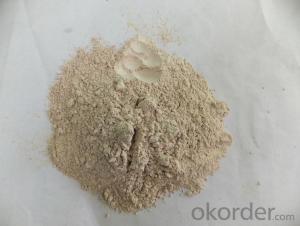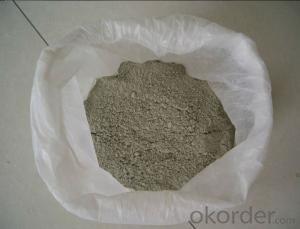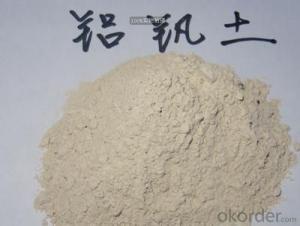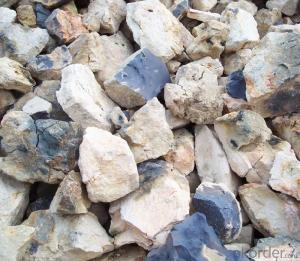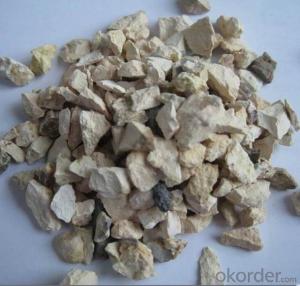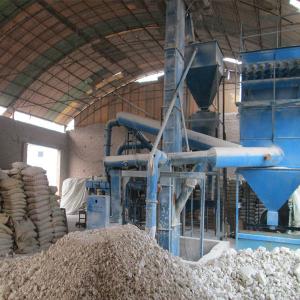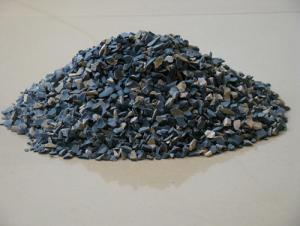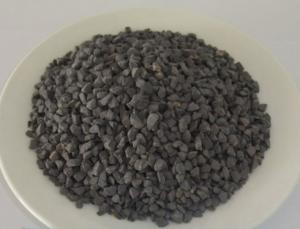Raw Materials for Refractory:Low Impurity High Alumina Calcined Bauxite in Bulk of CNBM in China
- Loading Port:
- Tianjin
- Payment Terms:
- TT or LC
- Min Order Qty:
- 11 m.t
- Supply Capability:
- 11111111 m.t/month
OKorder Service Pledge
OKorder Financial Service
You Might Also Like
Low Impurity High Alumina Calcined Bauxite in Bulk of CNBM in China
1.Structure of Calcined Bauxite Description
Bauxite (aluminous soil; Bauxite) is also called the alumina or bauxite, main ingredients are alumina, hydrated alumina containing impurities, is an earthy mineral. White or gray, brown and yellow or light red by iron. From 4 to 3.9 g/cm3 density, hardness, 1 ~ 3 is not transparent, very brittle. Very difficult to melt. Insoluble in water, soluble in sulfuric acid, sodium hydroxide solution. Mainly used for aluminium, refractory material.
2.Main Features of the Calcined Bauxite
Calcined bauxite is one of the principal ore of aluminum. Calcined bauxite contains hydrous aluminum oxides and aluminum
hydroxides, formed through the laterization of aluminous rocks in tropical and subtropical areas .Calcined bauxite is obtained by calcining (heating)superior grade bauxite at high temperature (from 85OC to 1600C) .This removes moisture there.By increasing the alumina content,compared to an alumina content of about 57%to 58% in raw bauxite, calcined bauxite has an alumina content of 84%to88%.The heating is carried out in rotary kilns.
3.Main usage of the Calcined Bauxite
(1) aluminium industry. Used in national defense, aerospace, automotive, electronics, chemical industry, daily necessities, etc.
(2) precision casting. Alumina clinker made after the mould precision casting processed into fine powder. Used in military industry, aerospace, communications, instrumentation, machinery and medical equipment department.
(3) is used for refractory products. High bauxite clinker refractoriness is as high as 1780, chemical stability strong, and good physical properties.
(4) aluminum silicate refractory fiber. With light weight, high temperature resistance, good thermal stability, low thermal conductivity, heat capacity is small and the advantages of resistance to mechanical shock. Used in iron and steel, nonferrous metallurgy, electronics, petroleum, chemical, aerospace, atomic energy, defense and other industries.
(5) in magnesia and bauxite clinker as raw materials, add the appropriate binder, used for pouring ladle whole ladle lining has particularly good effects.
(6) manufacture alumina cement, abrasive materials, ceramic industry and chemical industry can be aluminum of various compound.
4. Calcined Bauxite Images
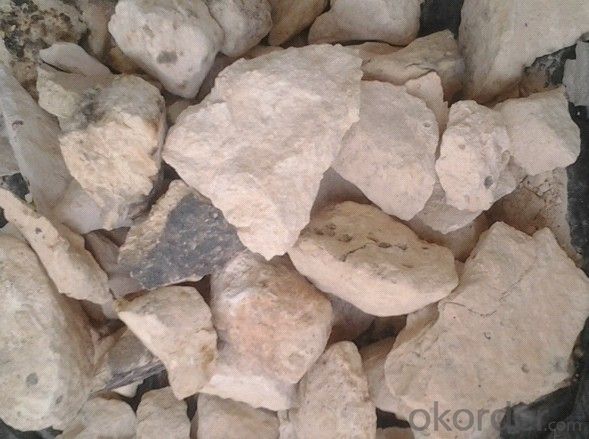
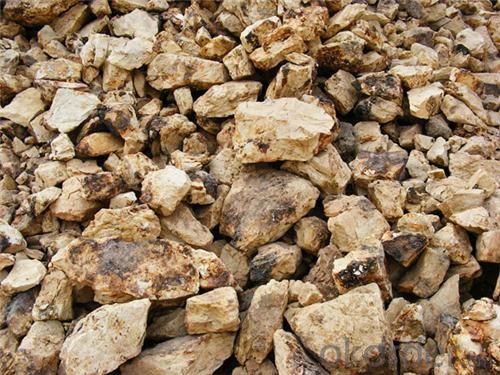
5. Calcined Bauxite Specification
| Place of Origin: | China (Mainland) | Shape: | Powder | Material: | Bauxite ore |
| SiO2 Content (%): | -- | Al2O3 Content (%): | 87.5% | MgO Content (%): | -- |
| CaO Content (%): | -- | Refractoriness (Degree): | Common (1580°< Refractoriness< 1770°) | CrO Content (%): | -- |
| SiC Content (%): | -- | Model Number: | HQB | Brand Name: | CNBM |
| Name: | Low Impurity High alumina calcined bauxite in bulk | Company: | CNBM | Type: | R&D- Production-Sales/Manufacture |
| Experience: | 51years | Certification: | ISO,CNAB,IAF | Main markets: | India,South Korea,Denmark, Russia, Europe, the United States |
| Fe2O3: | ≤1.6 | K2O: | ≤0.15 | Na2O: | ≤0.12 |
| Bulk Density: | ≥3.25g/cm3 |
♥ Research of application basis, new technical process and new technology, development of new product, and technical consultation.
♥ Optimum solution and product supply of refractories for high temperature industries, such as iron&steel, non-ferrous, petrochemical and building materials.
♥ Engineering design, contract and consult for refractories, and civil architecture design.
♥ Research,development, manufacture and sale of superhard materials.
♥ R&D, manufacture and sale of special packing materials for export.
♥ Inspection,supervision and arbitration of refractories.
♥ Consultation and services in refractories information.
♥ Training and cultivation of high-level talents in refractories profession.
6.FAQ of Calcined Bauxite
1). Q: Are you a factory or trading company?
A: We are a factory.
2). Q: Where is your factory located? How can I visit there?
A: Our factory is located in ShanXi, HeNan, China. You are warmly welcomed to visit us!
3). Q: How can I get some samples?
A: Please connect me for samples
4). Q: Can the price be cheaper?
A: Of course, you will be offered a good discount for big amount.
- Q: Is there vermiculite in refractory?
- Vermiculite is usually used as lightweight material in refractory field, and its volume density is about 0.5.
- Q: Please answer the questions about the packing and transportation requirements of refractory materials.. Requirements for packing of refractory bricks
- Bricks are usually made from pallets.Generally take the automotive, coastal sea city.
- Q: What is the concept of lightweight refractory material?
- Lightweight refractory material has high porosity, mechanical strength and erosion resistance. Compared with normal refractory bricks, it is a kind of refractory material with large volume shrinkage in high temperature, low thermal conductivity and small bulk density. It is used as thermal insulation material in industrial furnace and other thermal equipments. It has poor wear resistancel.
- Q: What are the types of advanced refractory?
- Hello there: Divided into two categories of general and special refractories ordinary refractories by chemical properties into acidic, neutral and alkaline. Special refractory composition is divided by high temperature oxide, refractory compounds and high-temperature composite materials Furthermore, according to refractoriness can be divided into ordinary refractory products (1580 ~ 1770 ℃), advanced refractory products (1770 ~ 2000 ℃) and grade refractory products (2000 ℃ above). the article can be divided into blocks (standard bricks, shaped bricks, etc. ), special shape (crucible, sagger, pipe, etc.), fibrous (aluminosilicate, zirconia and boron carbide quality, etc.) and a random shape (refractory clay, pouring materials and ramming mixes, etc.) according to the sintering process it can be divided into sintered products, cast products, melt blown products.
- Q: How many grades of fire?rating are there for interior decoration materials?
- It can be divided into construction classification and fire resistance rating. Fire prevention for buildings. Fire prevention measures should be taken in the architectural design to prevent fires and reduce fire hazards to life and property. Building fire protection includes two aspects: fire prevention before fire disaster and measures in fire disaster, among which the former is mainly to confirm the fire resistant rating and fire-resistant structure.
- Q: Does anyone know what is the use of waste refractory materials?
- 1.Waste refractory bricks can be reused to make the refractory bricks after being crushed by crusher, but the price is not very high. The purchasing price of refractory plant is ?60/ton. Because the refractory material has been calcinated for two times, it becomes easier to make bricks expansion coefficient with waste refractory bricks, but too much is inadvisable. If too much, the refractory materials would have a bad combination, which will give rise to loose bricks and incomplete corners. Nowadays, ordinary refractory plants would purchase waste refractory bricks to produce bricks, but better plants wouldn’t do this.
- Q: What parts of cement kilns are refractories used on?
- In kilns.
- Q: What is the the best matching ratio of refractory cement?
- The best matching ratio of refractory cement is 30%. Refractory cement is also known as aluminate cement. Aluminate cement takes bauxite and limestone as raw materials, alumina content of about 50% as the clinker. And it is a hydraulic cementing material made by grinding. Refractory cement is also known as aluminate cement. Aluminate cement is often yellow or brown or gray. The main mineral of aluminate cement is mono calcium aluminate (CaO · Al2O3, abbreviated CA) and other aluminates, and a small amount of dicalcium silicate (2CaO · SiO2), etc. It is a special cement. I hope my answer will be helpful to you.
- Q: Who can tell me the properties and classification of insulating refractories?
- The refractory materials refers to the refractory material of high porosity, low volume density, low thermal conductivity of the insulating material. Also called lightweight refractories. It includes insulating refractory products, refractory fiber and refractory fiber products.The characteristics of insulating refractory material is of high porosity, generally 40% to 85%; the volume density is low, generally less than 1.5g/cm3; the thermal conductivity is low, generally less than 1.0W (M - K). It is used as the insulation material of industrial furnace, furnace can reduce heat loss, save energy, and reduce thermal insulation equipment weight. The mechanical strength of refractory material, abrasion resistance and slag resistance is poor, should not be used for load-bearing structure of furnace slag, furnace, and direct contact with the molten metal and other parts.
Send your message to us
Raw Materials for Refractory:Low Impurity High Alumina Calcined Bauxite in Bulk of CNBM in China
- Loading Port:
- Tianjin
- Payment Terms:
- TT or LC
- Min Order Qty:
- 11 m.t
- Supply Capability:
- 11111111 m.t/month
OKorder Service Pledge
OKorder Financial Service
Similar products
Hot products
Hot Searches


